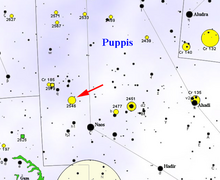NGC 2546

Prior to 2020, this cluster had been poorly studied. It was considered rather poor in stars but extensive with a Trumpler class of III 1m. The distribution was found to be elongated in a north–south direction with an angular size of 50′ x 25′. The cluster has an estimated 85 members brighter than visual magnitude 14.5. The age of the cluster was thought to be 3×10 years. Three Ap stars were detected. Cluster member AS Puppis is a candidate mass-losing AGB star.
A 2020 study by A. J. Alejo and associates demonstrated that two physically distinct stellar groups occupy the region of NGC 2546. Membership in the two clusters could be distinguished by multiple parameters, with the radial velocity, spectral type, and reddening from extinction being the most significant. The more populated cluster, designated NGC 2546A, is located at a distance of 3,100 ly (950 pc) and is about 180 Myr old with a half-member radius of 26 ly (8 pc). The second cluster, NGC 2546B, lies 4,700 ly (1,450 pc) from the Sun and is less than 10 million years old with a half-member radius of 5.2 ly (1.6 pc). The angular separation between the center of two clusters is 17′.
References
- ^ Tarricq, Y.; et al. (March 2021). "3D kinematics and age distribution of the open cluster population". Astronomy & Astrophysics. 647. id. A19. arXiv:2012.04017. Bibcode:2021A&A...647A..19T. doi:10.1051/0004-6361/202039388.
- ^ Alejo, A. D.; et al. (January 2020). "The nature of the NGC 2546: Not one but two open clusters". Astronomy & Astrophysics. 633. id. A146. Bibcode:2020A&A...633A.146A. doi:10.1051/0004-6361/201936294. hdl:11336/143175.
- ^ Frommert, Hartmut; Kronberg, Christine. "NGC 2546". SEDS. Archived from the original on 4 March 2016. Retrieved 6 July 2015.
- ^ Crossen, Craig; Rhemann, Gerald (2012). Sky Vistas: Astronomy for Binoculars and Richest-Field Telescopes. Springer Vienna. p. 119. ISBN 9783709106266.
- ^ "NGC 2546". SIMBAD. Centre de données astronomiques de Strasbourg. Retrieved 2024-03-11.
- ^ O'Meara, Stephen James (2013). Deep-Sky Companions: Southern Gems. Cambridge University Press. pp. 146–148. ISBN 9781139851541.
- ^ Lindoff, U. (1968). "The open clusters NGC 2546, Pi 1, NGC 2579, and Cr 185". Arkiv för Astronomi. 5: 63–103. Bibcode:1968ArA.....5...63L.
- ^ Maitzen, H. M. (November 1982). "A photoelectric investigation of Ap-stars in open clusters. III - NGC 2362, NGC 2546, and NGC 3228". Astronomy and Astrophysics. 115 (2): 275–279. Bibcode:1982A&A...115..275M.
- ^ Jura, M. (February 1987). "Mass-losing Red Giants in Open Clusters". Astrophysical Journal. 313: 743. Bibcode:1987ApJ...313..743J. doi:10.1086/165012.
External links
 Media related to NGC 2546 at Wikimedia Commons
Media related to NGC 2546 at Wikimedia Commons- NGC 2546 on WikiSky: DSS2, SDSS, GALEX, IRAS, Hydrogen α, X-Ray, Astrophoto, Sky Map, Articles and images